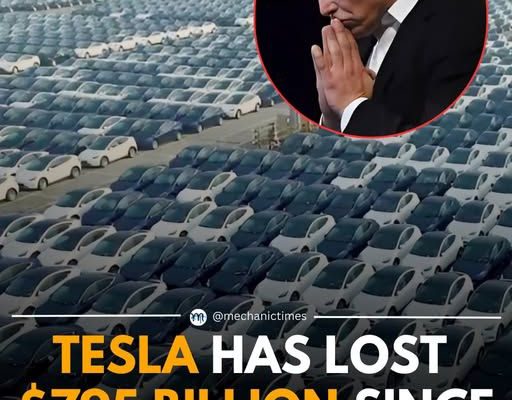In the realm of modern innovation, few companies have captured the world’s imagination like Tesla. From revolutionizing the electric vehicle industry to disrupting traditional automakers, Tesla stood as a symbol of progress, efficiency, and clean energy. But now, it stands as a symbol of something else: loss.
Since December 17th, Tesla has lost a jaw-dropping $795 billion in market value. That’s more than the GDP of most countries. This unprecedented plunge has left investors reeling, analysts speculating, and critics calling for accountability — especially from the company’s enigmatic CEO, Elon Musk.
How did this happen? What does it mean for Tesla’s future — and the future of electric vehicles (EVs) in general? This deep-dive article explores every corner of this collapse, revealing the data, decisions, and drama behind one of the most shocking financial declines in tech history.
The Numbers: A Breakdown of Tesla’s Collapse
Let’s start with the math. Between December 17th and March 24th, Tesla’s market capitalization dropped from nearly $1.23 trillion to under $435 billion.
That’s a 65% decline in just over three months.
This wipeout translates to:
- $795 billion in lost shareholder value
- A drop of over $300 per share
- One of the largest single-company losses in stock market history
The stock plunged due to a convergence of factors that only worsened with time. What once seemed like a short-term correction quickly snowballed into a full-blown crash.
What Went Wrong: A Perfect Storm of Pressure
Several forces contributed to Tesla’s historic fall:
- Market Conditions: Rising interest rates and inflation made growth stocks less attractive.
- Increased Competition: Legacy automakers like Ford, GM, and Volkswagen aggressively ramped up EV production.
- Internal Instability: Key executives resigned or sold massive amounts of stock.
- Public Confidence Falters: Quality issues, recalls, and delivery delays spooked consumers.
- Musk’s Distractions: Elon Musk’s controversial leadership of X (formerly Twitter) raised concerns about his focus and judgment.
Each of these issues fed into the next, creating a chain reaction of market panic.
Elon Musk: Visionary or Liability?
Elon Musk is no stranger to controversy, but in recent months, his behavior has become increasingly erratic.
- He sold tens of billions worth of his own Tesla shares to fund his acquisition of Twitter.
- He has repeatedly antagonized regulators and critics on social media.
- He slashed Tesla advertising and PR budgets while aggressively promoting his other ventures.
Critics argue that Musk has become a liability to Tesla, with some investors demanding he step down or appoint a new CEO.
Meanwhile, supporters claim Musk is still the genius behind the brand, and this turbulence is just another bump in Tesla’s meteoric journey.
Investor Sentiment: Panic or Patience?
In the aftermath of the market collapse, investors have split into two camps.
- Some are panicking, selling off their shares in droves, fearing further drops and a bleak outlook.
- Others are holding on, trusting in the long-term vision of EV growth and Tesla’s underlying tech.
Still, the dominant mood is uncertainty. Retail traders, once the backbone of Tesla’s stock surge, are now voicing concern in forums and financial platforms. Institutional investors are demanding more transparency from Tesla’s board.
The EV Market: Competitors Sensing Opportunity
While Tesla stumbles, other EV makers are pushing forward.
- BYD in China has overtaken Tesla in global EV sales.
- Legacy automakers are scaling production and improving battery tech, closing the innovation gap.
- New players like Rivian and Lucid are attracting investor interest, though they also face headwinds.
Tesla’s dominance is no longer guaranteed, especially with global governments pumping incentives into competitive local brands.
Internal Culture Shift: Behind the Curtain
- Employee turnover has increased, particularly at the executive level.
- Workplace morale is low, driven by chaotic communication, unclear direction, and Musk’s public controversies.
- Innovation appears to be slowing, with fewer major product announcements since the Cybertruck delay.
Tesla insiders are reportedly questioning the company’s long-term focus and whether innovation is being sacrificed for public stunts.
Regulatory and Media Pressure
- Tesla is under increased scrutiny from the SEC and NHTSA over everything from accounting practices to autonomous vehicle safety.
- Media coverage has turned sharply negative, with headlines focusing on losses, recalls, and Musk’s distractions.
- Governments are re-evaluating subsidies, asking whether Tesla still deserves the incentives it once did.
Public trust — once Tesla’s strongest intangible asset — is now on shaky ground.
Can Tesla Recover? Three Possible Futures
- The Rebound Scenario Tesla overcomes the turmoil, refocuses leadership, releases the Cybertruck and Robotaxi, and restores investor confidence.
- The Slow Decline Tesla loses market share steadily to competitors while Musk remains distracted, leading to stagnation.
- The Break-Up Investors pressure Tesla to separate Musk from day-to-day operations or even break up divisions (energy, vehicles, AI) to recover value.
Much depends on Musk’s next moves and Q2 earnings performance.
Conclusion
Tesla’s $795 billion loss is not just a number — it’s a reckoning.
It challenges the myth of untouchable tech visionaries, questions the sustainability of hypergrowth, and forces a hard look at leadership in times of crisis.
As the dust settles, the world is watching to see if Tesla can rebuild its legacy — or become the ultimate cautionary tale of 21st-century business.




